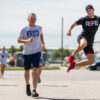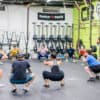One of the most popular cues coaches use when teaching and coaching the snatch and clean is to “Keep the bar as close to your body as possible.”
Biomechanically, we will all agree that anything close to our center of mass will be easier to lift. However, there is an explicit time and place for the bar to be extremely close to the body or come in contact with the body.
The most common errors we see in the lifts after separation almost always involve trying too hard to keep the bar close to the body. Many lifters will sacrifice proper position for contact with the bar. This results in a multitude of other issues later in the lift, which the athlete and coach spend countless hours correcting, while remaining oblivious to the root of the problem. Those lifters also find it challenging not to “bang the bar” with their hips or to finish their drive neutrally. As a result, they excessively hyperextend at the hip or keep their arms straight throughout the lift.
Believe it or not, space between the body and the bar is a good thing!
If you are still reading, let me answer the questions you are asking yourself right now.
So, when should the bar be close?
In chronological order-
- At separation, tracing the outside of the shins.
- Contact to initiate the vertical drive of the bar.
- During the transition, when the bar moves upwards while the lifter moves down.
When is space beneficial?
At the top of the “push” or “first pull,” before the knees re-bend to drive the bar vertically.
Proof! (Thank You HOOKGRIP!)
Why is space beneficial?
- Speed and Power in the “Drive”/ “2nd”
This happens because the bar has been pushed high enough for the hip and the knee to fire simultaneously and powerfully to create a large sum of force into the ground.
Many lifters will sacrifice this speed and power by attempting to keep the bar in constant contact with the body. This results in pulling the shoulders back too soon, opening and losing the hip. Also, the combination of losing the hip along with the bar dragging up the lifter’s thighs creates drag. DRAG IS SLOW!
- The lifter’s body and the bar collide together to create a vertical drive.
Pulling the shoulders back/failure to push to create space forces the hips forward, pushing at the bar, which results in horizontal (front to back) movement of the bar.
Any time the barbell is moving away from the lifter, the opportunity for the lifter to actively pull themselves down and under the bar is lost. The lifter then must rely on the “swing” of the barbell to be in the right position to catch it.
- Ability to keep the arms long and straight throughout the “Push”/”First Pull.”
This will result in a more powerful and efficient lift, allowing for the large and powerful muscles of the leg to act correctly. Those lifters who pull behind the bar will commonly use an early arm bend to pull the bar into the proper hip height to make contact. This results in the bar crashing hard on the lifter along with horizontal movement of the bar, making the transitions less efficient.
| We’ve all felt that bar come back and throat punch us, right |

Push to create space!
This is how I explain it to my lifters. The “push” or “first pull” of the lift does not stop once the bar crosses the knees. You must continue to push into the floor until the bar is high enough for the knee and hip to act together. You will feel like you are in a compromised position- you are! That feeling is the excessive hamstring stretch that will inevitably turn into a powerful muscle contraction.
Don’t sacrifice position for “Acceleration” early in the lift.
When the weights get heavy or the lifters do power variations of the lifts, the lifter feels like he or she has to put a little “extra” into it. This ALWAYS causes the shoulders to come back too soon, turning the lifter into a “puller” rather than a “pusher,” resulting in a poor lift as mentioned above.
How do you know if you are pushing long enough?
If you answer yes to any of the questions below, you need to PUSH- not PULL!
-Does the weight all of a sudden feel extremely heavy right before you drive (2nd pull)?
-Are your erectors (back muscles along the spine) doing all the work once you cross the knees?
-Are your erectors exhausted when you do hang or block work above the knee?
-Do you feel the bar dragging up your thighs?
-Can you not fix an early arm bend?
-Do you have to hyperextend just to “finish” your drive?
-Does the bar crash on you in the bottom of a squat when you snatch and clean?
-Do you feel “disconnected” from the bar when you transition into your squat?
These could all be the result of getting behind the bar too early.
Take note of America’s best snatcher, Colin Burns in this HOOKGRIP video. Note that first contact is made at the hip, not the thighs. As the bar crosses his knees, he continues to push into the ground almost fully extending his legs (but not disengaging his hamstrings) before he gets upright and attacks the ground at the same time.
Push Long and Drive Hard!
Phil Sabatini
M.S., C.S.C.S., USAW
Lecturer of Exercise Science
Old Dominion University
Human Movement Sciences
Phil is a former national champion and long time member of East Coast Gold Weightlifting. He is the Head Coach of the Barbell Syndicate at CrossFit Rife












